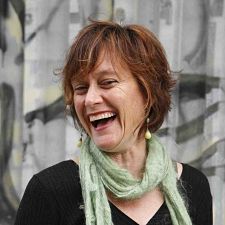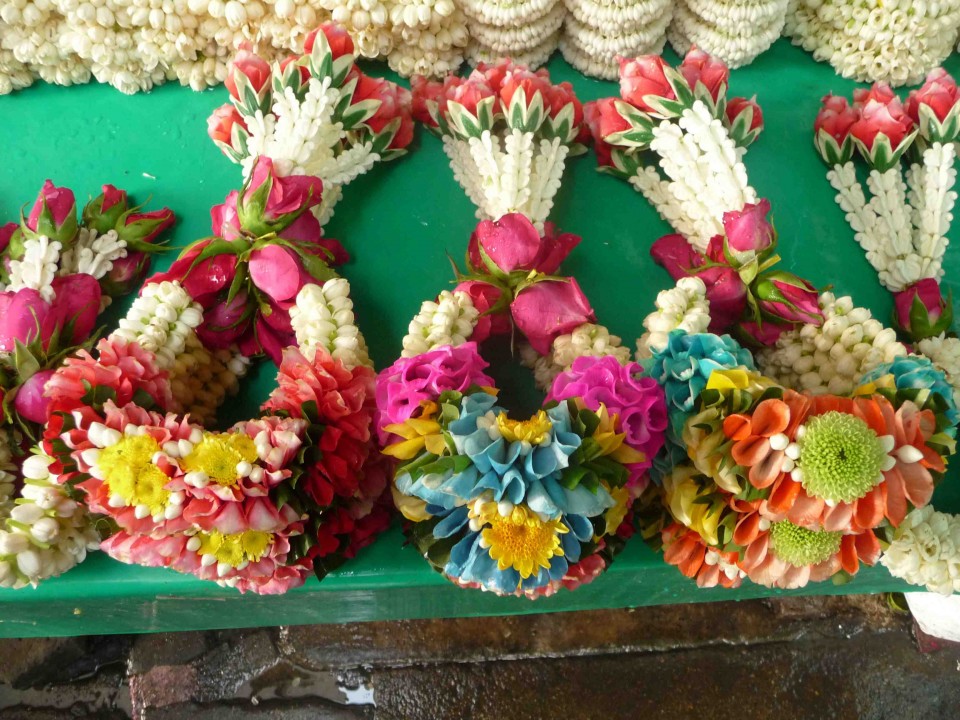SEASONAL SELF-CARE BLOG
Q & A with Jo Brill
Posted on September 2nd, 2015
We are delighted to present the Introduction to Sanskrit, with Jo Brill Sept 12, 13 through our Yoga Sukhavati: Art of Sound Module. Jo is a gifted and generous teacher and we are very excited to share her with you! We talked to Jo about her love of Sanskrit, how it enhances the teaching of yoga, and the many wonderful people she has met on her journey.
Where are you from originally? How long have you lived in NYC?
I was born upstate, in Troy, but grew up “in the middle” — Arkansas, Kansas, Missouri, Iowa. I’ve lived in New York State since 1980 when I started grad school, the first time, and I’ve lived in Peekskill (commuting distance!) since 1987.
How did you find yoga?
I started taking yoga after my first baby. Lucked into a wonderful teacher, Mia Azcue, the very first class and I have been her student since then!
How long have you practiced yoga? How long have you been teaching yoga?
I started practicing in 1988 or so — but casually. I got much more interested after a mid-life crisis in my 40s (I schedule one each decade!) and that’s when I sought out training, with Fran Ubertini, and began to teach — in 2004. Fran gave us several assignments to reflect on various yoga sutras, and I got frustrated with the variances in translation and interpretation! That’s what led me to Sanskrit.
How do you know Leigh?
I met Leigh when she signed up for a one-week intro intensive. That class was full of bright and loving people!! Of course Leigh was a ringleader!
Who is your sanskrit teacher?
I’ve studied with many wonderful teachers. My first teacher, Vyaas Houston, gave me invaluable tools for learning and focus — and his love of the Sanskrit theory of grammar proved contagious! I have had amazing opportunities to study with marvelous teachers at the University of Chicago, Oxford, Columbia, and Penn — some of the finest Sanskritists in the world. I must also mention Prof. Ramkaran Sharma, with whom I studied seven summers; his sweetness and brilliance as a teacher and a person is unparalleled.
What got you interested in Sanskrit? At what point did you decide you wanted to teach it yourself?
It was not the sound, though that attracts so many people. It was the philosophy. I wanted clarification! And I wanted it straight from the source, not distorted by commentary. Yes, I was a little naive!
Vyaas had us start teaching early. When I started in 2007, I’d been studying for just 18 months, and really didn’t know much! — but I was able to teach the alphabet using his wonderful method.
What is the most rewarding part of learning sanskrit?
Sanskrit continues to teach me about the incredibly complicated texture of human learning and culture. For a while I loved the neatness — you know, like math. Turns out, as with math, when you go far enough, things get less neat! I’m just grateful that somehow I found this language, so elegant and powerful, as well as the astoundingly huge multitude of texts it opens up for the reader.
As a yoga instructor, how does learning sanskrit beyond the names of asanas enhance ones teaching?
More and more, I feel that it’s important for westerners, many of us from variously privileged backgrounds, to remember that we are choosing to spend our time with cultural phenomena that are not ours by heritage. For our students’ sake too, it’s important not to be a jerk. Even inadvertently! While we may love the “exotic” for its power to show us truths about ourselves (more clearly perhaps than our own cultural practices do) — we should keep in mind that symbols, and certainly utterances, have religious and political implications we are almost certainly not fully aware of. It’s important to keep firmly in mind that we don’t know everything — on the contrary! Sanskrit has been for me a never-ending onion. Its layers and layers of meaning and significance are truly humbling.
What are you looking forward to most about being a part of Yoga Sukhavati’s Art of Sound module?
I absolutely love teaching this workshop. For one thing, I have met so many lovely people through Sanskrit. So when I walk in and see your faces, and hear your voices, I know that there are warm and precious connections to be made. For another — well, any time you spend hours with these sounds, you will have fun and you will go deep! Last, I know I will learn something. It’s through Sanskrit that I finally learned how grateful teachers are for students. I will love meeting each person!
You just returned from India. Any take-aways from this most recent trip that you would like to share?
It was only my second trip. I’m still processing, but again, I must emphasize the people. Brilliant and caring teachers, a warm and wonderful host family, and awesome fellow students who broadened my mind with their wide range of interests. Such generosity!
What is your favorite activity to do in NYC?
Hmmm, that’s difficult! Theater, maybe? But I also love to eat! Recently my two sons that live in Brooklyn have been showing me some great new restaurants. My third son has also treated me, but you didn’t ask about Boston!
Please add anything else you would like to share!
Until we meet, भद्रं ते !
Waterfall of thoughts
Posted on August 17th, 2015
Rejuvenate your being through mantra, and sonic marma healing. Join us for our second weekend in Yoga Sukhavati, Art of Sound module-HEALING POWER OF SOUND, Oct 3-4.
 Our modern lives are filled with excess of every kind. Perhaps central to all of this is our excessive mental chatter. Our minds are constantly spinning with obsessions, worry, fear, anxiety, excessive thoughts and repetitive habitual mind agitations of all sorts. This mind chatter can be so loud, persistent and overwhelming that it is often referred to in meditation as a “waterfall of thoughts”. Not a sweet waterfall, but the roaring, deafening kind! Ekhart Tolle, author of the “The Power of Now” has a wonderful story about this. One day he was walking one day behind this homeless person who was spewing out a non-stop crazy monologue. At first Ekhart was disturbed by the man’s ramblings. Then he had a realization that in some way, he was quite similar to this man-that he too had a constant monologue going on inside his head. He chuckled to himself as he realized that the only difference was that the homeless person was speaking his monologue out loud and Ekhart was just spinning his monologue inside his head.
Our modern lives are filled with excess of every kind. Perhaps central to all of this is our excessive mental chatter. Our minds are constantly spinning with obsessions, worry, fear, anxiety, excessive thoughts and repetitive habitual mind agitations of all sorts. This mind chatter can be so loud, persistent and overwhelming that it is often referred to in meditation as a “waterfall of thoughts”. Not a sweet waterfall, but the roaring, deafening kind! Ekhart Tolle, author of the “The Power of Now” has a wonderful story about this. One day he was walking one day behind this homeless person who was spewing out a non-stop crazy monologue. At first Ekhart was disturbed by the man’s ramblings. Then he had a realization that in some way, he was quite similar to this man-that he too had a constant monologue going on inside his head. He chuckled to himself as he realized that the only difference was that the homeless person was speaking his monologue out loud and Ekhart was just spinning his monologue inside his head.
Scattered, fragmented, obsessive, repetitive thoughts and disjointed rambling speech are signs that our heart-mind is out of balance. I think that would be most of us alot of the time! The wisdom of Chinese Medicine encourages us to nourish our heart and small intestine in the Summer months when these organs & meridians are particularly affected. The heart-mind is said to sprout at the tongue. One of the most powerful ways to nurture and calm the heart-mind is through the power of sound. Mantra practice is a potent sonic healing. The Sanskrit word mantra is derived from “manas”-mind and “tra”- tool. It is a tool for the mind, one of the most powerful means to calm the mind. They are often referred to as mind protection. Mantras power comes not from the meaning of the words but from the energetic effect they have on the physical and subtle body.
“Mantras break-up unhealthy or negative energy patterns stored in the physical and subtle bodies and help create new, positive energy patterns. This “clean” energy animates the body and mind and can act as a magnet for other positive energy to come into your life.”
“Mantra allows the chakras to “switch on” safely and to operate at a higher “wattage.” When we practice Sanskrit mantra, we increase the ability of the chakras to hold a spiritual charge. It is as if a 25-watt bulb becomes able to hold 50 watts, then 100 watts, 500 watts, 1,000 watts. Mantra’s power derives not from any particular meaning that their syllables convey, but from the vibrational effect the create when they are pronounced repeatedly…when we focus the sound vibration of mantra with a consciously held intent, we can even direct its energy (prana) to specific parts of the body.” (Thomas Ashley Farland)
I have worked alot with sound to help me unravel stuck areas in my being that I am not able to reach through asana or other means. The healing power of the sonic vibrations of sound is very potent. This Summer I have been working deeply with a Ganesh mantra. I often open my classes with this chant as well as do it in my personal practice. But this Summer I decided to do the full traditional 40 day practice of 108 recitations per day. My intention was to create groundedness and stability in my life particularly in the financial realm. I am truly amazed at how quickly things started shifting and stabilizing! New opportunities have presented themselves and I’ve been releasing old patterns that create instability in my mind and life.
MAHA GANAPATI MOOL MANTRA
Om srim hrim klim glaum gam ganapataye svaha
“May the abundance-producing, great remover of obstacles, that transcends this apparent reality bring all things that concern me under my control.”
It brings me great joy to share some of these sound practices with you through our second weekend of Yoga Sukhavati: HEALING POWER OF SOUND, Oct 3, 4. Amanda Capobianco will be offering her fabulous workshop-Demystifying Mantra: A Practical Approach to an Ancient Technology. I will be offering workshops on “Awaken the voice of the teacher” and “Sonic Marma Healing.” Join us for for a powerful weekend of sound exploration and healing!
Om……
Leigh
Sing to your hearts content
Posted on June 16th, 2015
Open up your voice and sing from your heart to infuse your spirit with the joyful abundance of Summer.
I took this picture when I was in Thailand in 2014 studying Thai massage with master teacher, Pichest Boonthumee. My favorite thing to do when traveling in Asia is to get up early and walk through the open air markets. The streets and markets are buzzing with life and vitality. Our first day studying thai massage with Pichet, we were to arrive at 9am with offerings- flowers, incense, and fruit. So I got up early and went to the market. I was mesmorized by the intricate beautiful flower offerings that were on display. People of all walks of life were purchasing them on their way to work. The daily flower art offerings hung everywhere, on the mirror in the rickshaws, on the bow of the boats, in the restaurants, on the spirit houses and temples. Gratitude in the form of these beautiful ephemeral works of flower art were lusciously everywhere. They make me so happy.
As the Summer solstice is here, I share with you the beauty of these flower offerings. Our gardens are blooming and the bounty of the Summer is shining everywhere. According to Chinese Medicine, Summer is the time to nourish the heart and small intestine. When talking about the heart, Chinese medicine includes the physical heart as well as the mind or consciousness of our being. The heart circulates the blood through the body, houses the spirit, and is responsible for maintaining awareness. The heart-mind is said to sprout at the tongue. Speech and song emerge from the heart center as fragrant blossoms emerging from the stem and root. I am reminded of our phrase in English “Sing to your heart’s content”.
People with a balanced heart-mind shine not only through their generous, joyous, loving presence but also through their clarity of speech and thought. They are good communicators, highly articulate and aware. For most of us, unfortunately, our heart-mind’s are scattered and confused. Constant media stimulus and the fragmentation of our modern lives leaves us with frighteningly short attention spans, and a constant stream of agitated, anxious thoughts whirling in our mind. Our thoughts become diffused, disjointed, and our speech confused or rambling. These are signs that our heart-mind is out of balance.
To strengthen the heart-mind and gather your scattered thoughts, sing and explore voice centered practices this Summer. It is the perfect time to delve into the beautiful Indian devotional chanting practices of kirtan, and mantra. Chanting in the sacred language of Sanskrit helps focus your mind and invites forward your innate state of spaciousness, clarity and pure awareness. Chanting is like a vibrational form of flower offerings-strings of sacred sound garlands offered from the heart.
“The word mantra is derived from the words manama (‘thinking’) and trana ( ‘liberation’). In other words, a mantra is a potent form of thought, an instrument of conscious intention.
Georg Feuerstein, “The Yoga Tradition”
‘Because the mantra is an expression of a more evolved consciousness, it offers a unique link with that higher level. For this reason, it not only makes the path to higher consciousness clearer by replacing interfering thoughts, its gradual incorporation pulls consciousness toward that state.’”
Swami Rama, “Yoga & Psychotherapy”
Join us for joyful sonic explorations this Summer through our Art of Sound Module!
Enjoy!
Leigh



